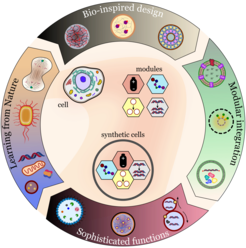Synthetic Cells: From Simple Bio-Inspired Modules to Sophisticated Integrated Systems
This review article presents recent advances in the field of bottom-up synthetic biology, with a focus on the development of complex synthetic cells from simpler functional modules. The state of the art in this field is rich with new materials, strategies, and methods that provide a comprehensive toolbox to researchers interested in developing life-like systems. Our review article provides a critical collection of selected examples from the synthetic bottom-up biology toolbox. The information in our review article is organized from bottom to top, with basic modules presented first before discussing integrated systems. This review article will help researchers understand the current challenges in the field of bottom-up synthetic biology and inspire new technological applications in biomedicine, tissue engineering, and life-like materials chemistry.

A "bottom-up" process creates complexity by integrating simpler building blocks or modules. This approach is used by researchers attempting to recreate one of nature's most complex systems, the cell. In the field of bottom-up synthetic biology, the type, quality, and ingenuity of building blocks for constructing integrated systems, i.e., synthetic cells that mimic or extend the properties of living cells, have increased substantially. The contents of this toolbox of methods and materials are the subject of our review article. We begin by describing basic biomimetic modules dedicated to compartmentalization, energy production, protein expression, cell-cell communication, replication of genetic material, growth/division, and motility. We then turn our attention to systems that integrate basic functional modules to generate complex biomimetic properties. Here we present work describing systems that have solved complex engineering problems, including protein expression in energy self-sufficient synthetic cells and even self-replication (gene expression + division). Finally, we discuss examples of synthetic cells engineered to study and explore challenging properties such as adaptability and evolution. Our bottom-up approach to writing this review article allows readers to understand the strategies, challenges, and opportunities of synthetic biology. Readers interested in life-like systems and complex hierarchical materials will find valuable information that will inspire the development of new technologies.












